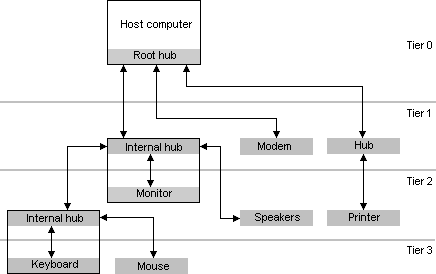
USB is a tree-structured bus, which in the vocabulary of the Universal Serial Bus Specification is a star-tier topology. The host computer contains a single root node, or hub, of the USB tree. This hub mediates between its host computer and any peripheral devices. Hubs have exactly one connection, called an upstream port, to higher levels in the USB tree. Hubs can have up to seven downstream ports for connecting peripheral devices and other hubs. By connecting hubs together, up to 127 devices can be attached to the host computer. Peripheral devices are always leaf nodes within a USB bus. However, as a matter of practical implementation, many USB peripheral devices have hubs integrated into them, so users typically do not need to purchase separate USB hubs.
The following illustration shows a USB bus with several common peripherals connected. This illustration is modeled after the diagram of a typical USB bus configuration in the Universal Serial Bus Specification, Revision 1.0, but with the hubs and peripheral devices represented more explicitly.

The association of the mouse with the keyboardís internal hub and the speakers with the monitorís internal hub is entirely arbitrary. For example, a user could instead connect the mouse to the monitorís internal hub, the modem to the keyboardís internal hub, and the speakers to the stand-alone hub in Tier 1 without affecting the systemís functionality and without having to reconfigure any software on the host computer.